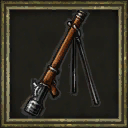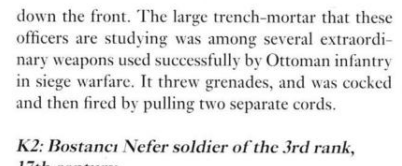Making widespread usage a requirement is a bit too restrictive in my opinion. It’s fun to have a chance at using some exotic and wacky units. Asian and African countries regularly hired European advisors so mercs can be conceptualized as a proxy for that.
I’m totally fine with expensive novelty units being included as mercenary units. That totally fits with their role as strong units with a high coin and population cost. Stuff like Giant Grenadiers are too cool not to include and fit in best as mercs. The only other way to have them would be some kind of limited elite unit like Sipahi available to either a reworked German or Prussian civ and I don’t see that as likely.
That being said, the line between what constitutes a mercenary and what doesn’t is way too blurry. Some of them are dubious or completely wrong.
Worst Offenders:
Arsonist - This is by far the worst categorized merc. It is unequivocally an outlaw, not a mercenary. If there needs to be a merc in this role, Mysorean Rocketeers would work great (the Brits copied their rockets so that could be how to explain them being mercs).
Crabat - The opposite counterpart to the Arsonist. Crabats are totally a mercenary, not an outlaw. Their promotion mechanic is also not compatible with being an outlaw, since cheap early units that have incredible scaling can’t not be busted.
Royal Horseman - Half the royal house units are lazily named “royal ____” and they seriously thought it necessary to add another “royal ____” that’s a merc? Not only is the name unnecessarily confusing, the function also doesn’t fit at all. Why is a unit that’s supposed to be a bodyguard stampede around like a rampaging elephant stomping on everything nearby? Some kind of elephant merc would have been a way cooler way to have this mechanic (or applying it to all elephant units).
Questionable KoM Mercs:
Giant Grenadier - Discussed above.
Mounted Rifleman - This is kind of a generic unit, but I’m not really sure where it could be fit in if not as a merc. It’s kind of like Fusiliers where it’s very generic, but conflicts with the standard roster too much to really fit in. What they should at least do is use it to show off the dismounting mechanic. They literally functioned as light infantry and heavy cavalry so a dismounting merc would be a perfect way to implement it. And lastly, why on God’s green earth is it not called Chasseur?
Pandour - Really should be a standard skrim unit for an Austrian civ or at least a unit for the Habsburg royal house. Counter-skirms are just not well implemented in general so they aren’t a great unit in the first place.
For the rest, the Irish fought all over the continent, Bosniaks served as mercs for Prussia, and Armored Pistoleers use very expensive gear, so they all make perfect sense.
Questionable TAR Mercs:
Sennar Horseman - Not a mercenary as far as I can tell. Would be a good unit for a Sudanese civ in the unlikely event they are ever added. Swapping places with Dervishes could also make sense.
Kanuri Guard - On the surface these guys seem like just a way to represent Bornu. But they could also be reasonably justified as hired guards to protect the trans-Saharan trade routes, so I’m fine with them.
Zenata Rider - They’re actually a reasonable fit for a merc. They served overseas in Granada and inspired the Jinetes.
The rest are all expensive, elite, or hired widely so they fit well as mercs.
Standard Units as Mercs:
Sepoy - Basically the Indian equivalent of Askari. They should clearly become a merc if anything is ever done about reworking the British Raj abomination.
Gurkha - All the same issues as Sepoys.
Keshik - It would make a lot of sense to swap them with Manchus. China is very heavily Qing, so Manchus would fit right in their standard roster. Keshiks were elite Mongol guards so being a weak standard unit is not a great fit. They were also used more widely given the size and legacy of the Mongol empire.
Papal Lancers - They are based on the exact same thing as Elmeti and could replaced by Elmeti.
Organ Guns - There’s always complaints about them not being Portuguese and they are a niche artillery unit that could make sense as a merc.
Conflicting Roles
As for mercs being too similar, I think organizing them into mercenary companies could be a way to address that. Batching them together in like groups would let you have similar variants without the risk of your entire merc roster being the same because of bad luck.


